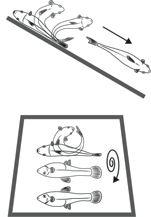Some fish will leap out of water to escape a predator, but the dramatic exit doesn’t do much good without an effective technique for returning. The mosquitofish, it turns out, not only finds its way back—it chooses the most energy-efficient method for doing so.
Stop-action photography and analysis from the lab of Alice Gibb, professor of biology at Northern Arizona University, reveals that the mosquitofish will either roll or leap back to the water, depending on body position on a slope. The findings, which appear in PLOS One, help answer a fundamental question about how animals make the transition to new habitats.
According to Gibb, the sensory system that governs balance and orientation may be the fundamental system to allow vertebrates to make the transition from life in the water to life on the land—an observation with evolutionary implications. “We would expect this to be true for the first vertebrates to emerge onto land as well,” Gibb said.
“Our findings suggest that the otolith vestibular system, which senses the body’s orientation relative to gravity in all vertebrates, may require no modification when an animal moves onto land,” Gibb said. “This sensory system that evolved to allow a fish to determine its orientation in the three-dimensional medium of water works well enough on land to allow a fish to return home.”
That conclusion contrasts with what is known about senses such as sight and smell, which can be highly specialized to function well in water but not on land.
Gibb opened the way to these new insights with earlier research detailing a tail-flip jump used by certain bony fishes to return to water after leaping onto land. Now it appears the tail-flip, which is a highly coordinated behavior, is used only in certain circumstances because of the energy required. But a roll “effectively moves a fish back into the water and may ‘cost’ very little in terms of energetics,” Gibb said.
The path to this conclusion arose from questions about how a fish might cope with the unusual environment of land from a “behavioral-sensory perspective,” Gibb said. “When a fish launches itself onto land to evade a predator, it is, by definition, stranded. How does an aquatic organism determine where it is on land, relative to water?”
Gibb chose the mosquitofish as a research subject because of its “unusual lifestyle”: it is fully aquatic, yet willing to leave the water and move about on land voluntarily. Stop-action photography has allowed Gibb and her colleagues to capture behaviors that appear to be uncoordinated thrashing—familiar to anyone who has seen a fish on shore attempting to return to water. These movements, however, are not random body contractions, but instead represent coordinated behaviors that effectively move the animal back into its home environment.



